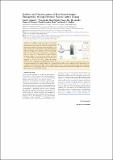Por favor, use este identificador para citar o enlazar a este item:
http://hdl.handle.net/10261/184299COMPARTIR / EXPORTAR:
 SHARE SHARE
 CORE
BASE CORE
BASE
|
|
| Visualizar otros formatos: MARC | Dublin Core | RDF | ORE | MODS | METS | DIDL | DATACITE | |

| Título: | Synthesis and characterization of blue faceted anatase nanoparticles through extensive fluorine lattice doping |
Autor: | Calatayud, David G. CSIC ORCID ; Jardiel, Teresa CSIC ORCID ; Peiteado, Marco CSIC ORCID ; Illas, Francesc; Giamello, Elio; Palomares, F. Javier CSIC ORCID; Fernández Hevia, D.; Caballero Cuesta, Amador CSIC ORCID | Palabras clave: | Fluorine Lattices Minerals Nanoparticles Oxides |
Fecha de publicación: | 10-sep-2015 | Editor: | American Chemical Society | Citación: | Journal of Physical Chemistry C 119(36): 21243- 21250 (2015) | Resumen: | An effective synthesis strategy for the extensive fluorination of the TiO2 anatase lattice has been developed which provides a highly stable blue-colored titania powder. The process also produces a convenient faceted morphology of the doped nanoparticles. Both theoretical and experimental data indicate an ordered atomic structure, in which an exceptionally high amount of fluorine ions substitute oxygen ions in the TiO2 lattice. The extra-electrons borne by fluorine are stabilized by lattice Ti cations via a mechanism of valence induction, eventually leading to a consequent high amount of reduced Ti3+ centers. Such structure, whose general formula can be expressed as Ti4+(1-x)Ti3+xO2–(2-x)F–x, confers an excellent stability to the as-synthesized nanoparticles (in spite of the excess electrons), explaining for example why the blue color is retained even upon storage in ambient atmosphere. But moreover, the high concentration of the relatively shallow Ti3+ generated states also form a sort of sub-band close to the bottom of the conduction band itself. The whole effect results in a tangible decrease (0.2 eV) of the anatase band gap which allows an inspiring upgrading of its UV photocatalytic activity. Our results also suggest that narrowing the band gap is insufficient for a substantial improvement in the visible light harvesting. | Versión del editor: | https://doi.org/10.1021/acs.jpcc.5b06923 | URI: | http://hdl.handle.net/10261/184299 | DOI: | 10.1021/acs.jpcc.5b06923 | Identificadores: | doi: 10.1021/acs.jpcc.5b06923 e-issn: 1932-7455 issn: 1932-7447 |
| Aparece en las colecciones: | (ICV) Artículos (ICMM) Artículos |
Ficheros en este ítem:
| Fichero | Descripción | Tamaño | Formato | |
|---|---|---|---|---|
| Calatayud_Synthesis_JPC_C_119_21243-21250_postprint.pdf | Artículo principal-Vs Postprint | 1,61 MB | Adobe PDF |  Visualizar/Abrir |
CORE Recommender
SCOPUSTM
Citations
28
checked on 17-abr-2024
WEB OF SCIENCETM
Citations
28
checked on 23-feb-2024
Page view(s)
197
checked on 19-abr-2024
Download(s)
7
checked on 19-abr-2024
Google ScholarTM
Check
Altmetric
Altmetric
NOTA: Los ítems de Digital.CSIC están protegidos por copyright, con todos los derechos reservados, a menos que se indique lo contrario.
